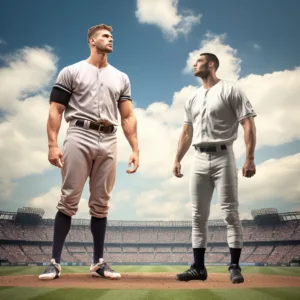 Are you searching for the answer to Does Weight Affect Velocity? Then this article has what you need and more!
Are you searching for the answer to Does Weight Affect Velocity? Then this article has what you need and more!
The saying "Mass equals Gass" has resonated deeply within the baseball community, offering a fresh perspective on the impact of a player's body weight on their ability to deliver fast pitches. Far from being a mere catchphrase, this principle is deeply rooted in scientific studies and empirical data, suggesting a significant correlation between a pitcher's physique and their pitch velocity. It challenges traditional notions, encouraging a reevaluation of training protocols and performance strategies to harness the full potential of an athlete's body composition.
In exploring the nuanced relationship between mass and velocity, this article aims to dissect the layers of scientific evidence supporting the "Mass equals Gass" theory. We aim to bridge the gap between theoretical knowledge and practical application, offering insights into how players can optimize their physical attributes for improved performance on the mound. By examining the biomechanics of pitching, the physiological effects of increased body mass, and the latest research findings, we embark on a journey to unlock the secrets of pitching velocity. This exploration not only promises to enlighten players and coaches alike but also to inspire a paradigm shift in the approach to baseball training and performance enhancement.
Understanding the Basics: Does Weight Affect Velocity?
 The phrase "Mass equals Gass" has sparked considerable debate and interest within the baseball community, positing the theory that a player's body weight is intrinsically linked to their ability to achieve greater pitching velocity. This claim is far from being just speculation because a body of empirical research and scientific evidence backs it up, painting a convincing picture of how physical mass can affect athletic performance. This exploration is not just academic; it has practical implications that could transform the way baseball players train and perform. By delving into the nuanced relationship between a pitcher's mass and their speed on the mound, this article aims to shed light on how such insights can be harnessed to usher in a new era of baseball training methodologies that emphasize power, precision, and performance.
The phrase "Mass equals Gass" has sparked considerable debate and interest within the baseball community, positing the theory that a player's body weight is intrinsically linked to their ability to achieve greater pitching velocity. This claim is far from being just speculation because a body of empirical research and scientific evidence backs it up, painting a convincing picture of how physical mass can affect athletic performance. This exploration is not just academic; it has practical implications that could transform the way baseball players train and perform. By delving into the nuanced relationship between a pitcher's mass and their speed on the mound, this article aims to shed light on how such insights can be harnessed to usher in a new era of baseball training methodologies that emphasize power, precision, and performance.
Understanding the interplay between weight, mass, and velocity in the context of baseball pitching requires a foundational knowledge of these physical concepts and their application in sports science. Weight refers to the force that gravity exerts on an object's mass, which in turn, is a measure of the amount of matter contained within that object. These fundamental principles of physics have a profound impact on a pitcher's ability to throw with speed and force. The mechanics of pitching are deeply intertwined with the principles of mass and force, where the effective management and application of a player's body weight can either serve as a catalyst for achieving remarkable velocity or act as a barrier to performance. The following sections will further dissect these dynamics, illustrating how an understanding of weight and mass can be leveraged to enhance pitching velocity, thereby revolutionizing the approach to training and performance optimization in baseball.
Insights from Key Studies: Does Weight Affect Velocity?
 The exploration into the effects of body weight on pitching velocity has been thoroughly examined through various scientific studies, each contributing valuable insights into the complex dynamics of baseball pitching. The 2013 study by Lehman G, Drinkwater EJ, and Behm DG is a key piece of research because it established a clear connection between a pitcher's lower body strength and their capacity to throw at higher speeds. This finding underscores the critical importance of developing a strong physical foundation, highlighting that the power generated from the lower half of the body is instrumental in propelling the ball with greater velocity.
The exploration into the effects of body weight on pitching velocity has been thoroughly examined through various scientific studies, each contributing valuable insights into the complex dynamics of baseball pitching. The 2013 study by Lehman G, Drinkwater EJ, and Behm DG is a key piece of research because it established a clear connection between a pitcher's lower body strength and their capacity to throw at higher speeds. This finding underscores the critical importance of developing a strong physical foundation, highlighting that the power generated from the lower half of the body is instrumental in propelling the ball with greater velocity.
Building on this foundation, the comparative analysis by Escamilla R and his colleagues offers an intriguing look at the differences between American and Korean professional baseball pitchers. This study illuminates how distinct training methodologies and cultural approaches to baseball training can lead to varying outcomes in pitching performance. By examining the kinematic and kinetic profiles of pitchers from these two backgrounds, the research provides a nuanced understanding of how tailored training regimens can optimize a player's physical attributes to enhance pitching velocity.
Werner SL's research in 2008 further delves into the relationships between ball velocity and the mechanics of throwing, offering an analytical perspective on the biomechanical aspects that contribute to effective pitching. This work is invaluable for coaches and athletes alike, as it provides a detailed breakdown of the mechanical efficiencies and inefficiencies that can affect a pitcher's performance.
Lastly, the 2018 study by Makhni EC, Lizzio VA, Meta F, and colleagues represents a significant advancement in our understanding of the pitching motion, specifically examining the torque applied to the elbow during various pitches, including fastballs, curveballs, and change-ups. By assessing the physical demands and potential risks associated with different types of pitches, this research offers critical insights into injury prevention and the optimization of pitching techniques to maintain high velocity while minimizing the risk of injury.
Together, these studies form a comprehensive body of knowledge that significantly advances our understanding of the impact of body weight on pitching velocity. They not only reinforce the importance of physical strength and conditioning but also highlight the need for a tailored approach to training that considers the unique biomechanical and physiological characteristics of each pitcher. Through the application of these insights, players and coaches can develop more effective training programs that enhance performance and reduce the risk of injury, further pushing the boundaries of what is possible in the realm of baseball pitching.
The Role of Body Weight in Pitching Mechanics: Does Weight Affect Velocity?
 The influence of body weight on pitching mechanics is a nuanced and multifaceted aspect of baseball performance that, when harnessed correctly, can significantly enhance a pitcher's capabilities on the mound. The crux of this relationship lies in the biomechanical advantages that an increased body mass can provide, specifically in the realm of force generation. A pitcher's ability to generate force is pivotal to the velocity of their throw; thus, a well-conditioned increase in mass can be a game-changer, enabling the athlete to deliver pitches at higher speeds. This is because the kinetic energy behind a pitch, and consequently its velocity, is partly a function of the mass moving forward in the pitching motion. More mass moving at the same speed translates to more energy transferred to the ball.
The influence of body weight on pitching mechanics is a nuanced and multifaceted aspect of baseball performance that, when harnessed correctly, can significantly enhance a pitcher's capabilities on the mound. The crux of this relationship lies in the biomechanical advantages that an increased body mass can provide, specifically in the realm of force generation. A pitcher's ability to generate force is pivotal to the velocity of their throw; thus, a well-conditioned increase in mass can be a game-changer, enabling the athlete to deliver pitches at higher speeds. This is because the kinetic energy behind a pitch, and consequently its velocity, is partly a function of the mass moving forward in the pitching motion. More mass moving at the same speed translates to more energy transferred to the ball.
However, the process of augmenting body mass for pitching benefits is not without its intricacies. Simply adding mass without a strategic focus on conditioning and functional strength can lead to a decline in overall athletic performance. The additional mass must be in the form of lean muscle, strategically developed around the core, legs, and shoulders to enhance the pitcher's ability to generate force without compromising their speed, agility, or flexibility. This careful balance ensures that the added strength translates directly to pitching velocity rather than becoming a hindrance.
Moreover, the integration of increased mass into pitching mechanics must be undertaken with a keen awareness of the potential for injury. An unbalanced increase in mass, especially if not accompanied by proportional strength and flexibility training, can place undue stress on critical joints and ligaments involved in the pitching motion, particularly the shoulder and elbow. These areas are already highly susceptible to injury due to the intense, repetitive forces exerted during pitching. As such, conditioning programs aimed at increasing a pitcher's mass must be meticulously designed to enhance the body's resilience and adaptability, ensuring that the pitcher can handle the increased force generation without an elevated risk of injury.
In essence, the role of body weight in pitching mechanics is a delicate balance between harnessing the power of increased mass for greater velocity and ensuring that this advantage does not come at the cost of the pitcher's health and mobility. The strategic conditioning of body mass, tailored to the unique needs and capabilities of the individual pitcher, can indeed unlock new levels of performance, making the understanding and application of these principles a cornerstone of modern baseball training programs.
Training Strategies for Optimizing Body Mass and Velocity: Does Weight Affect Velocity
 Optimizing body mass and velocity is a critical component of a pitcher's development, requiring a nuanced approach to training that balances strength, flexibility, and technique. The goal is to enhance performance while minimizing the risk of injury, a challenge that necessitates a comprehensive training strategy. For athletes and coaches aiming to navigate this complex landscape, TopVelocity Training emerges as a leading solution, offering a scientifically backed, holistic approach to developing the elite baseball athlete.
Optimizing body mass and velocity is a critical component of a pitcher's development, requiring a nuanced approach to training that balances strength, flexibility, and technique. The goal is to enhance performance while minimizing the risk of injury, a challenge that necessitates a comprehensive training strategy. For athletes and coaches aiming to navigate this complex landscape, TopVelocity Training emerges as a leading solution, offering a scientifically backed, holistic approach to developing the elite baseball athlete.
Integrating Strength and Conditioning: Does Weight Affect Velocity?
At the core of optimizing body mass for pitching velocity is a robust strength and conditioning program. TopVelocity Training emphasizes the importance of building functional muscle mass that directly contributes to pitching performance. This involves targeted exercises that focus on the lower body, core, and upper body, particularly the shoulders and forearms. Squats, deadlifts, and lunges, for example, are integral for lower body strength, while planks, Russian twists, and medicine ball throws bolster core stability. For the upper body, exercises like the dumbbell press, rows, and band-resisted pitching movements are crucial. These exercises are designed not just to build muscle but to enhance the explosive power essential for pitching.
Flexibility and Mobility Work: Does Weight Affect Velocity?
Equally important to strength in the TopVelocity Training philosophy is flexibility and mobility. The ability to move through a full range of motion with control and efficiency can significantly impact pitching mechanics and velocity. TopVelocity programs incorporate dynamic stretching, yoga, and mobility drills that focus on enhancing flexibility in the hips, shoulders, and spine. Such practices not only improve performance but also play a critical role in injury prevention, ensuring that pitchers can maintain high velocity over the long term.
Technical Skill Development: Does Weight Affect Velocity?
Understanding and refining pitching mechanics are paramount in the TopVelocity Training approach. Through video analysis and biomechanical assessment, pitchers can identify and correct inefficiencies in their motion, ensuring that every ounce of effort translates into velocity. This technical skill development goes hand in hand with physical conditioning, as optimized mechanics reduce unnecessary strain on the body and leverage the strength and power built through training.
Nutritional Guidance: Does Weight Affect Velocity?
Recognizing the role of nutrition in athletic performance, TopVelocity Training offers comprehensive nutritional guidance to support muscle growth, recovery, and overall health. A balanced diet rich in lean proteins, complex carbohydrates, healthy fats, and hydration forms the backbone of a pitcher's nutritional plan. Tailored to the individual's needs, this dietary strategy ensures that the body has the necessary fuel to perform at its peak and recover efficiently.
Customized Training Plans: Does Weight Affect Velocity?
What sets TopVelocity Training apart is its commitment to customization. Recognizing that every athlete is unique, the program offers personalized training plans that consider the pitcher's current capabilities, goals, and areas for improvement. This individualized approach ensures that pitchers receive the most effective training for their specific needs, maximizing their potential for growth in body mass and velocity.
Navigating the Path to Elite Performance: Does Weight Affect Velocity?
For pitchers and coaches dedicated to achieving elite performance, TopVelocity Training provides a comprehensive, evidence-based framework for success. By focusing on the integrated development of strength, flexibility, technical skills, and nutrition, TopVelocity equips athletes with the tools they need to optimize their body mass and velocity, setting a new standard in baseball training. Aspiring pitchers looking to elevate their game are encouraged to explore TopVelocity Training, where they'll find the expertise and support necessary to achieve their highest potential.
Join the TopVelocity Elite Training Camps
Ready to elevate your pitching game to new heights or unleash your full potential as a position player? The journey to becoming an elite baseball athlete starts here, with TopVelocity's specialized training camps. Whether you're a pitcher aiming to break through velocity barriers or a position player looking to optimize performance, we have the perfect camp for you.
 For Pitchers: Join our 3X Velocity Camp, designed specifically for pitchers determined to increase their throwing speed, refine their mechanics, and reduce injury risk. Our evidence-based training methods and personalized coaching will help you unlock explosive power and achieve your pitching goals.
For Pitchers: Join our 3X Velocity Camp, designed specifically for pitchers determined to increase their throwing speed, refine their mechanics, and reduce injury risk. Our evidence-based training methods and personalized coaching will help you unlock explosive power and achieve your pitching goals.


Why choose TopVelocity?
- Science-Backed Training: Our programs are rooted in the latest sports science, ensuring you receive the most effective and efficient training possible.
- Customized Coaching: We understand that every athlete is unique. Our camps offer personalized coaching to address your specific needs and objectives.
- Comprehensive Development: Beyond just velocity, we focus on strength, agility, mechanics, and injury prevention to develop well-rounded athletes.
- Community and Support: Join a community of like-minded athletes and coaches all working towards the common goal of excellence in baseball.
Don't let another season pass by without reaching your full potential. Take the first step towards becoming the best version of yourself on the baseball field. Sign up now for the 3X Velocity Camp for pitchers or the 2X Velocity Camp for position players and start your journey to elite performance today. Spaces are limited, so secure your spot and transform your game with TopVelocity!
For more exclusive content become a TopVelocity Patreon Pro Member!
Reference
Lehman, G., Drinkwater, E. J., & Behm, D. G. (2013). Correlation of throwing velocity to the results of lower-body field tests in male college baseball players. The journal of strength & conditioning research, 27(4), 902-908.
Escamilla, R., Fleisig, G., Barrentine, S., Andrews, J., & Moorman III, C. (2002). Baseball: kinematic and kinetic comparisons between American and Korean professional baseball pitchers. Sports Biomechanics, 1(2), 213-228.
Werner, S. L., Suri, M., Guido Jr, J. A., Meister, K., & Jones, D. G. (2008). Relationships between ball velocity and throwing mechanics in collegiate baseball pitchers. Journal of shoulder and elbow surgery, 17(6), 905-908.
Makhni, E. C., Lizzio, V. A., Meta, F., Stephens, J. P., Okoroha, K. R., & Moutzouros, V. (2018). Assessment of elbow torque and other parameters during the pitching motion: comparison of fastball, curveball, and change-up. Arthroscopy: The Journal of Arthroscopic & Related Surgery, 34(3), 816-822.

